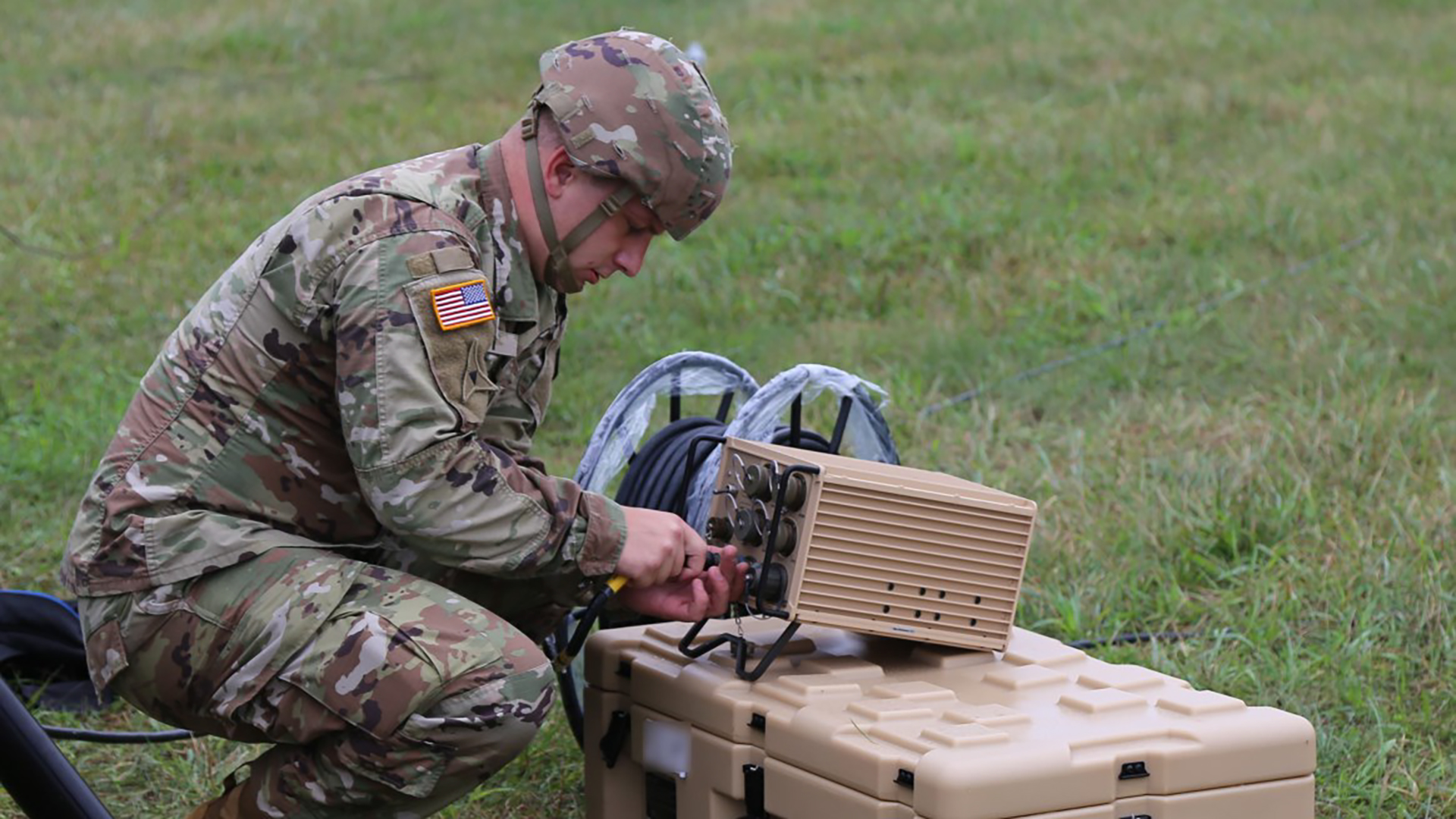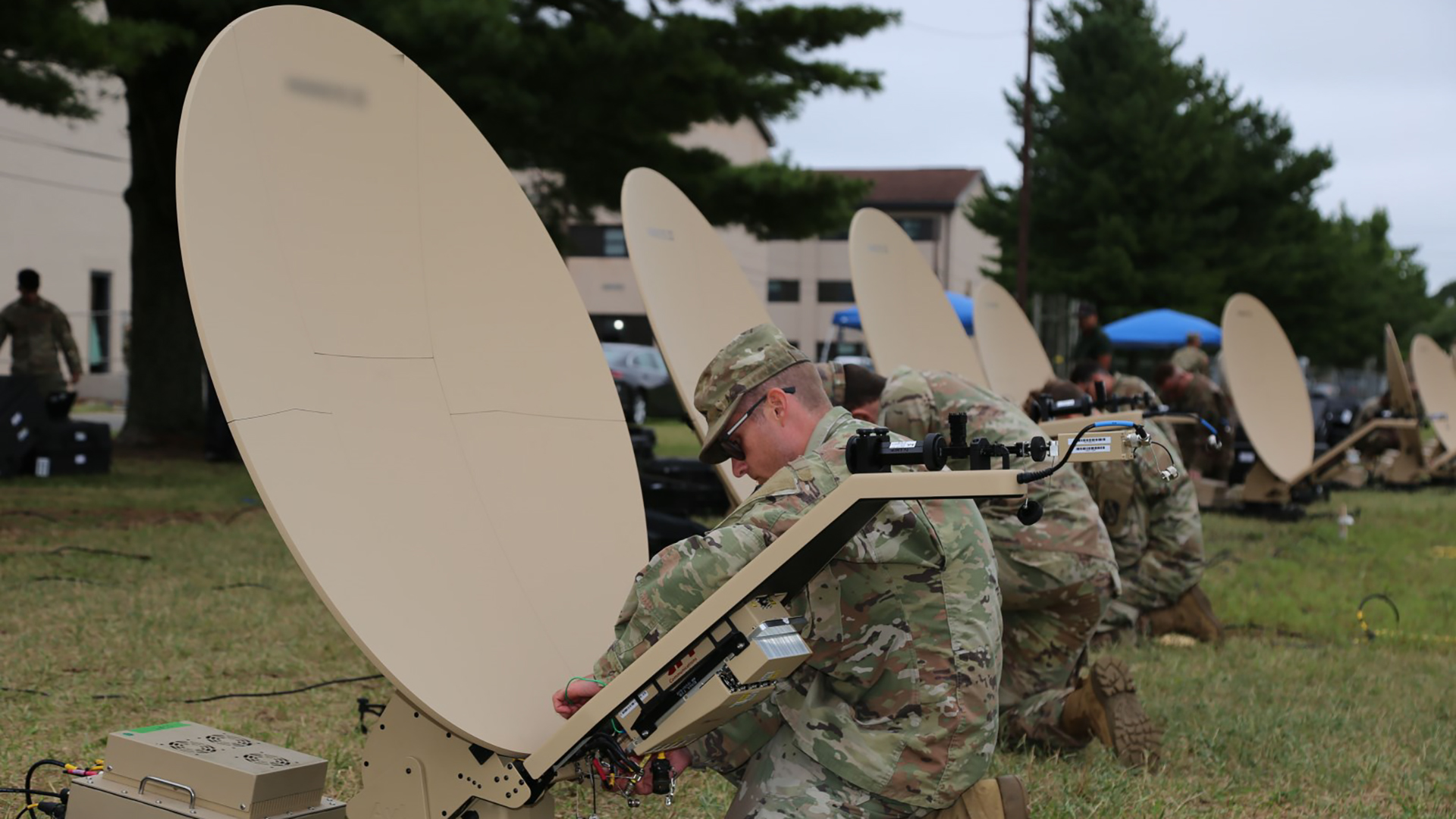The 392nd ESB-E Fielded with Modernized Kit
Enhancing comms
Article, photos by Amy Walker
PEO C3N Public Affairs
Article published on: September 1, 2024 in the Army Communicator Fall/Winter 2024 Edition
Read Time: < 5 mins

A Soldier from 392nd ESB-E trains on the high-capacity TRILOS at Joint Base McGuire-Dix-Lakehurst, New Jersey.
In line with the Army’s continual network transformation efforts, the service has been arming its expeditionary signal battalions with an agile scalable network transport equipment package that enhances network connectivity, speed of deployment and battlefield maneuverability - all critical elements to mission success in future large scale combat operations.
“From a strategic perspective, this enhanced communications capability offers joint force and Army commanders a much-improved lightweight and agile command and control (C2) package in support of short notice missions spanning the full spectrum of operations, from humanitarian assistance to large scale combat,” said Maj. Gen. Jan Carl Norris, commanding general for U.S. Army Reserve 335th Signal Command (Theater).
The modernized expeditionary signal battalionenhanced (ESB-E) baseline network systems include various-sized expeditionary satellite dishes and baseband equipment, high-capacity backhaul radios, wireless command post technologies and network enclaves that enable coalition data exchange. The equipment package enables these formations to more effectively provide commanders with the global network connections and data exchange they need to execute C2 in complex battlefield environments.
“[Our signal] teams will no longer be tied to heavy vehicle-based equipment and are able to shoot, move, and communicate more rapidly with their new kits, in a theater where threats will be tracking their every movement,” said Lt. Col. Mitri Baroudi, commander of the recently modernized Maryland U.S. Army Reserve 392nd ESB-E, assigned to the 359th Theater Tactical Signal Brigade, 335th Signal Command (Theater).
“Scalability and small form factor are the keys to this equipment,” Baroudi said. “The ability to appropriately scale the equipment loadout to meet mission requirements enables each team to become that much more expedient in their movements and setup times, and the low profile in overall footprint allows teams to setup in discreet locations should the mission require.”
The Army’s Project Manager Tactical Network (PM TN), at the Program Executive Office Command, Control, Communications, and Network (PEO C3N), completed the 392nd ESB-E’s new equipment training and fielding on the equipment set at Joint Base McGuire-Dix-Lakehurst (JB MDL), New Jersey, in September, officially converting the unit from an ESB to an ESB-Enhanced formation. ESB-Es provide or augment the network transport capabilities of other Army units. Since 2021, the Army has been modernizing several ESB-Es each year across all three components – Active Army, Army Reserve and Army National Guard. During a typical rotation, the 392nd ESB-E supports real-world operations across the U.S. Central Command and European Command areas of responsibility.
The smaller lighter transit case-based ESB-E equipment enables teams to deploy via commercial air with their baseline equipment checked as baggage - a more dynamic and expeditious manner of employing communications systems that the battalion hadn’t been able to do before, said Command Sgt. Maj. Brent Hamill, senior enlisted officer for the 392nd ESB-E.
“These kits will expand each team’s ability to get from home station to the intended deployment location within hours, versus weeks of moving our old heavy equipment via air or sea,” Hamill said.
As U.S. joint and coalition forces continue to work side-by-side in current and future complex operational landscapes, the Army places a high priority on mission partner interoperability, so that data can be fluidly exchanged, and coalition forces can contribute to a common operational picture. The ESB-E equipment set includes Commercial Coalition Equipment (CCE), a core component of a Mission Partner Environment that enables expeditionary coalition or commercial network connectivity to enable C2, network communications and situational awareness between the combined forces.

Soldiers from 392nd ESB-E train on SNN satellite terminals at Joint Base McGuire-Dix-Lakehurst, New Jersey, on Aug. 8.
Sgt. Austin Vongdara, network communication systems specialist for B Company, 392nd ESB-E, previously deployed with his unit to Europe, where they supported U.S. Army forces in the shadow of the evolving Russia and Ukraine War. Vongdara agreed that in comparison, the unit’s new smaller lighter kit would be more beneficial in a future large scale combat operation, where mobility will be crucial to survivability and lethality.
“The new kit is scalable; if we need to support a higher echelon, we can just plug multiple nodes together to support more troops. It’s versatile; we can plug-and-play different nodes together. And it’s mobile; you don’t know what is going to happen out there in the field, so if worst comes to worst, we can pack up [and rapidly relocate] at moment’s notice,” Vongdara said.
To increase network resiliency in current and future congested and contested battlefield environments, the ESB-E tool suite enhances Primary, Alternate, Contingency and Emergency (PACE) network communication plans by providing more signal path options through the use of different high-throughput beyond-line-of-sight (BLOS) and terrestrial transport systems. Looking forward, future transport options are expected to include high throughput, low latency (HT/LL) multi-orbit satellite communications, as well as automatic-PACE capabilities that enable seamless cross over between systems without Soldier intervention, enabling Soldiers to better focus on the fight. Fiscal year 24 pilots for both of these capabilities are informing Army fielding decisions on each of these capabilities.
In line with the Army’s network transformation priorities, all of the modernized ESB-E systems are easier to operate and much faster to set up and tear down, enhancing mobility, while reducing Soldier burden and enabling new Soldiers to more rapidly become proficient on multiple systems. The reduced system complexity and size of the new equipment enables ESB-Es to significantly increase their network support to other units with more nodes and less manpower.
The recent training of the baseline equipment set at JB MDL was the first time Spc. Camden Crissinger, 392nd ESB-E network system specialist, was hands-on with the new equipment. Yet, when he and a partner set up the high-throughput Terrestrial Transmission Line of Sight (TRILOS) Radio, including fully extending the system’s 30-foot mast, they were able to break an ongoing training record by a full minute.
“Just like the trainers described in the abbreviation of SWaP [size, weight and power], everything is smaller and it’s easy to handle,” said Crissinger, who also previously deployed with the unit and its larger kit. “With this equipment, we are leaving less of a footprint, and it will be much easier to send smaller teams out in an expeditionary manner to get mission requirements done.”
The U.S. Army Program Executive Office Command, Control, Communications, and Network (PEO C3N) develops, acquires, fields and supports the Army's holistic Unified Network (Tactical and Enterprise) to ensure force readiness in both current missions and potential future large scale combat operations. This critical Army modernization priority delivers resilient terrestrial and satellite communications capabilities to ensure commanders and Soldiers remain connected and informed at all times, even in the most austere and hostile environments. PEO C3N is delivering an integrated Unified Network to regions around the globe, enabling high-speed, high-capacity voice, data and video communications to an Army user base that includes joint, coalition and other mission partners.